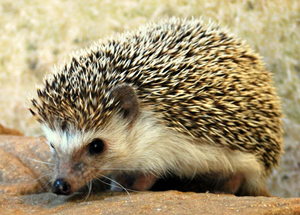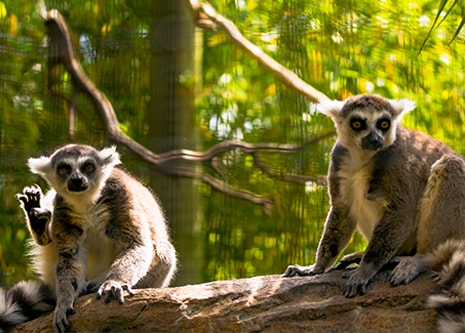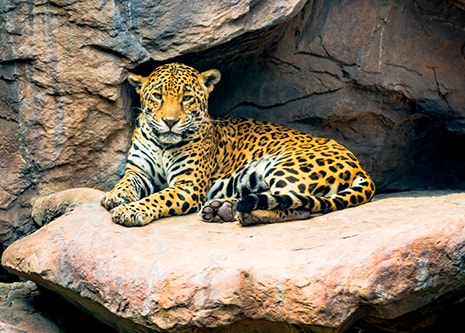
- VisitSupport Happy HollowDONATE TODAYExploreSupport Happy HollowDONATE TODAYLearnSupport Happy HollowDONATE TODAYSupport
-
Today's Hours: 10:00 am to 4:00 pm
Education AmbassadorsAfrican four-toed hedgehog

Scientific name: Atelerix albiventris
Family: Erinaceidae
Order: Erinaceomorpha
Class: Mammalia
Range: Sub-Saharan Africa
Habitat: Grassland
Lifespan: 1 to 4 years old in the wild; 4 to 6 years old in captivityWhat do they look like?
African four-toed hedgehogs are five to seven inches long, oval-bodied mammals, with spines covering the top of their head and back. They vary in color from light tan to dark brown. Their spines range between ¼ to ¾ inches long and, unlike porcupine quills, do not have barbs on the tips. They have short legs, big ears, long snouts and small eyes.How do they behave?
Hedgehogs are solitary, nocturnal (active mainly at night) animals. They have poor vision and rely highly on smell, touch, and hearing to navigate and hunt. Hedgehogs can travel several miles in a single night searching for food. If they encounter a predator, hedgehogs roll tightly into a ball, protecting their head, belly, and legs. If further harassed, the hedgehog is likely to jolt and hiss in an attempt to ward off the predator. Hedgehogs display a strange habit of self anointing or “anting” when introduced to a new or particularly strong-smelling substance. This behavior produces frothy saliva which they then spread onto their spines. Hedgehogs prefer moderate temperatures and will often burrow and enter either a state of estivation (slowed to no activity in the summer) or hibernation (slowed to no activity in the winter).What do they eat?
Hedgehogs are opportunistic omnivores (animals that eat both animals and plants). Their main diet consists of insects, supplemented with small snakes, amphibians, bird eggs, snails, worms, fruit, and grass roots. They require a diet high in protein, low in fat, and must also consume chitin, found in the exoskeletons of insects. They have a high tolerance for toxins and have been seen consuming toxic plants, poisonous amphibians, and even scorpions! At Happy Hollow, hedgehogs are fed insectivore diet, hard boiled eggs, fruits, vegetables, crickets and mealworms.How are they born?
Hedgehogs do not have a specific breeding season. The female will ovulate when conditions are optimal and a male is present. This typically occurs in the rainy season when food is plentiful. The pups are born after a gestation period of approximately 35 days. Typical litter size is usually three to four pups. The young are born helpless and blind with soft hairs that eventually form spines. Pups reach their adult size by the time they are approximately two months old. Females generally have one to two litters each year.Conservation
The African four-toed hedgehog is common throughout its range in Africa and its conservation status is listed as Least Concern by the International Union for Conservation of Nature . To promote local conservation, several states including Arizona, California, Georgia, Hawaii, Maine and Pennsylvania, have outlawed their residents from owning these hedgehogs as pets. Climates in these areas could provide all the necessities for hedgehogs to create viable populations and negatively impact native wildlife. One way you can help maintain wild populations of African four-toed hedgehogs is to educate your friends about them and refrain from purchasing them as pets. These actions ensure that both African four-toed hedgehogs and your local wildlife have healthy habitats.
Zoo on the Hill
Located across from the Keep-Around Carousel is the Zoo on the Hill. Learn about wildlife up close during daily meet-and-greets, leap like a lemur on the playground, brush and feed the goats,, or take a peek inside Doc’s Critter Care building and the Ranch House. Double-H Ranch features a combination of animal exhibits, including giant anteaters and red ruffed lemurs, as well chickens and domesticated animals that are docile enough to touch.
See Animals
Zoo in the Hollow
Follow the crooked bamboo pathway down into the hollow and visit with some of the most amazing animals in the world. Where else in San José can you get up close to a stunning jaguar, lemur, meerkat or American alligator? Happy Hollow is dedicated to helping save species and preserve wildlife for future generations by participating in Species Survival Plan programs through the Association of Zoos and Aquariums.
See AnimalsVisit Us Today
Plan an unforgettable experience at San Jose’s family-friendly park and zoo.
more info